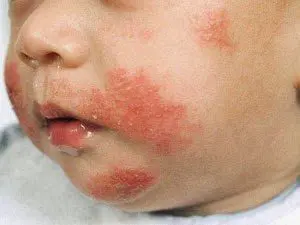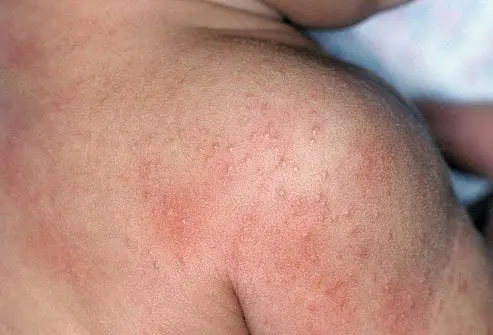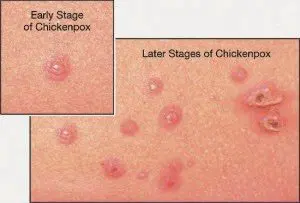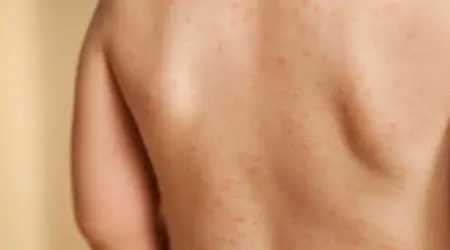I remember the day my first child got his first rash. I went to change his diaper and was frightened to find his whole body covered in odd little red dots. When the dots didn’t go away, I ended up taking him to the doctor. Once I did, I got a good case of man-do-I-feel-like-an-overly-paranoid new mom. His doctor said that baby rashes are common, and sometimes it’s hard even as a doctor to say why, but in most cases baby rashes are harmless and require no medical attention. She also said I was far from the first mom to worry over a baby rash. Now with four babies grown into kids, I’ve seen a decent amount of rashes, especially with that first baby having some super sensitive skin. I can say with all honesty I wish I had a baby rash decoder five years ago. So, I decided to make one.
Please be aware that this article is not meant to substitute medical advice. If your baby has a rash accompanied by other signs of sickness, is showing signs of pain, or the rash has been present for an extended amount of time, please ignore any feelings you may have that you’ll look like a paranoid new mom and just go to the doctor.
My baby’s rash is red, itchy, scaly patches:
 |
| Baby Eczema on the cheeks |
Baby Eczema: Eczema is a skin condition that is usually genetic. Babies with eczema have a thinner outer layer of skin that allows more allergens in, resulting in patch-like pink, itchy rashes and dry scaly skin. Eczema is most common on the ankles, wrists, and back of the knees, but it can occur anywhere. Infants often get it on the cheeks as well. Minor cases can be treated with an over-the-counter moisturizer and the use of soaps/products for sensitive skin. Severe cases may require prescribed topical lotions. Baby eczema often clears up around age 5, though it can extend into adulthood.
 |
| Rare Infant Psoriasis |
Psoriasis: Psoriasis is caused by skin cells maturing too quickly, causing a build-up in red, scaly, raised patches. This rash is commonly seen on the lower back, elbows, knees and scalp, but is not common in infants. Psoriasis requires medical treatment.
 |
| Ring worm |
Ring worm: Ring worm is not actually caused by a worm under the skin, but by a fungus. Ring worm is highly contagious and most babies that have one spot will get more. This is why they can be mistaken for a rash. Ring worm will appear in red patches with a scaly outer ring. It can be treated with an over the counter anti-fungal. Note that jock itch and athlete’s feet are also both forms of ring worm.
My baby’s rash is just scaly skin:
Dry skin: if the area is not red, simply scaly, it’s possible your baby just has a patch of very dry skin. Try a sensitive skin moisturizer.
Eczema: Minor cases may appear as scaly patches of hardened skin. See above for more information.
 |
| Cradle Cap |
Cradle cap: Cradle cap is most common on the scalp, but may extend onto the face into eyebrows. It will appear as dry, scaly patches which may also have a yellow to gold crusting. Cradle cap can usually be resolved by rubbing moisturizing oil into the patches during baths and then rinsing the scales away.
My baby’s rash is red with pimple-like blisters:
 |
| Heat Rash |
Heat rash: Heat rash, sometimes called prickly heat rash, will present as numerous small red bumps which may or may not been filled with fluid. The area, or your baby’s body as a whole, may also be slightly red. This rash is caused heat as the name implies. Undress your baby and wipe him/her with a cool, wet cloth and the rash should fade over the next hour or so.
 |
| Diaper Rash |
Diaper rash: If the rash is in the diaper area and also involves raised and/or raw patches of skin, it’s possible your baby has diaper rash. Be sure to keep your baby’s diaper dry and apply a topical baby rash cream. If the rash persists, it may be yeast-based or from a food intolerance.
White patches in the mouth or on the tongue can be a good indication of a yeast-based rash.
 |
| Oral Thrush |
These white patches are called thrush. Most infants that get yeast-based diaper rashes also get thrush and vice versa, because of this it’s recommended you see your pediatrician, especially if breast feeding. Thrush can be spread to the glands of the nipple. However, if you know it is just the rash, an over-the-counter yeast infection cream (such as Monistat) will also work.
Folliculitis: This is simply infected or clogged hair follicles. The rash would appear in pimple-like boils around the hair follicle itself. It is common in areas where clothing may rub with your baby’s skin such as the underarms and groin.
 |
| Impetigo |
Impetigo: Of all the possible causes of pimple-like blisters, impetigo is usually the most severe. It may appear as a patch of bumps which form into a boil and then burst and crust over. Impetigo is highly contagious, and so spreads quickly as sores begin to ooze, but it usually begins near the mouth. In mild cases, impetigo resolves itself if the area is kept clean. In severe cases, antibiotics will be required.
Keep in mind that the common cold sore somewhat resembles impetigo and also forms blisters which burst and then form a crust. Cold sores do not require antibiotics and in cases can even come in patches, but they are highly contagious. The two are difficult to tell apart. When dealing with either issue it’s best to wash your hands thoroughly after contact and seek a medical opinion if symptoms continue for more than a week.
My baby’s rash is just white bumps:
 |
| Large Patch of Milia |
Milia: Milia is very common in babies. It appears most commonly on the face as small white bumps. These bumps are dead skin trapped within pores. They will eventually go away on their own. Milia may be just a random bump or two, or has pictured more of a patch-like area.
 |
| Infant Acne |
Baby acne: If those same bumps are red, show signs of irritation, or have a bit of fluid, your baby may have acne. Acne also resolves itself. Simply keep your baby’s skin clean and leave the bumps alone.
Newborn Rash: Shortly after birth, your baby may have yellow to clear patches of bumps anywhere on the body. There also may be redness around the patches. This is called newborn rash, and its cause is unknown. It does resolve itself without care.
My baby’s rash is small red dots:

 |
| Scabies |
Scabies: Scabies are a microscopic mite which can live in the skin. The rash will appear as small red bumps in patches that will itch, a lot. Scabies is usually found between the fingers or on the wrists. Scabies requires a prescription and are very contagious. A good way to check for scabies is to use a felt-tipped marker and dab the rash. If the ink bleeds into tunnel-like trails, it is likely scabies. If the ink stays in one solid dot, it’s less likely to be scabies.
 |
| Viral Rash |
Viral rash: Some viruses come with a rash. These bumps usually aren’t raised and are just, little red dots. They will go away with the virus.
My baby’s rash has raised patches:
 |
| Hives |
Hives: Hives are caused by an allergic reaction. They will be skin-colored to red raised patches which may itch. While a bath may help, hives usually resolve as the body stops reacting to the allergen. If your baby exhibits breathing difficulties or excessive swelling, immediately seek medical attention.
Hives may be alone or accompanied by small red itchy bumps, this is usually a sign of an allergic reaction. The small bumps may also be found without hives, this is more common in contact rashes from touching something that irritated the skin due to allergy or otherwise. Hives are often a sign of a more severe allergic reaction with swelling being more indicative of a possible medical emergency.
Baby drool rash: Baby drool rash is caused by irritation from moisture on the skin. It will appear as raised, red patches. Drool rash can evolve into impetigo. Keep your babies face dry to avoid drool rash.
